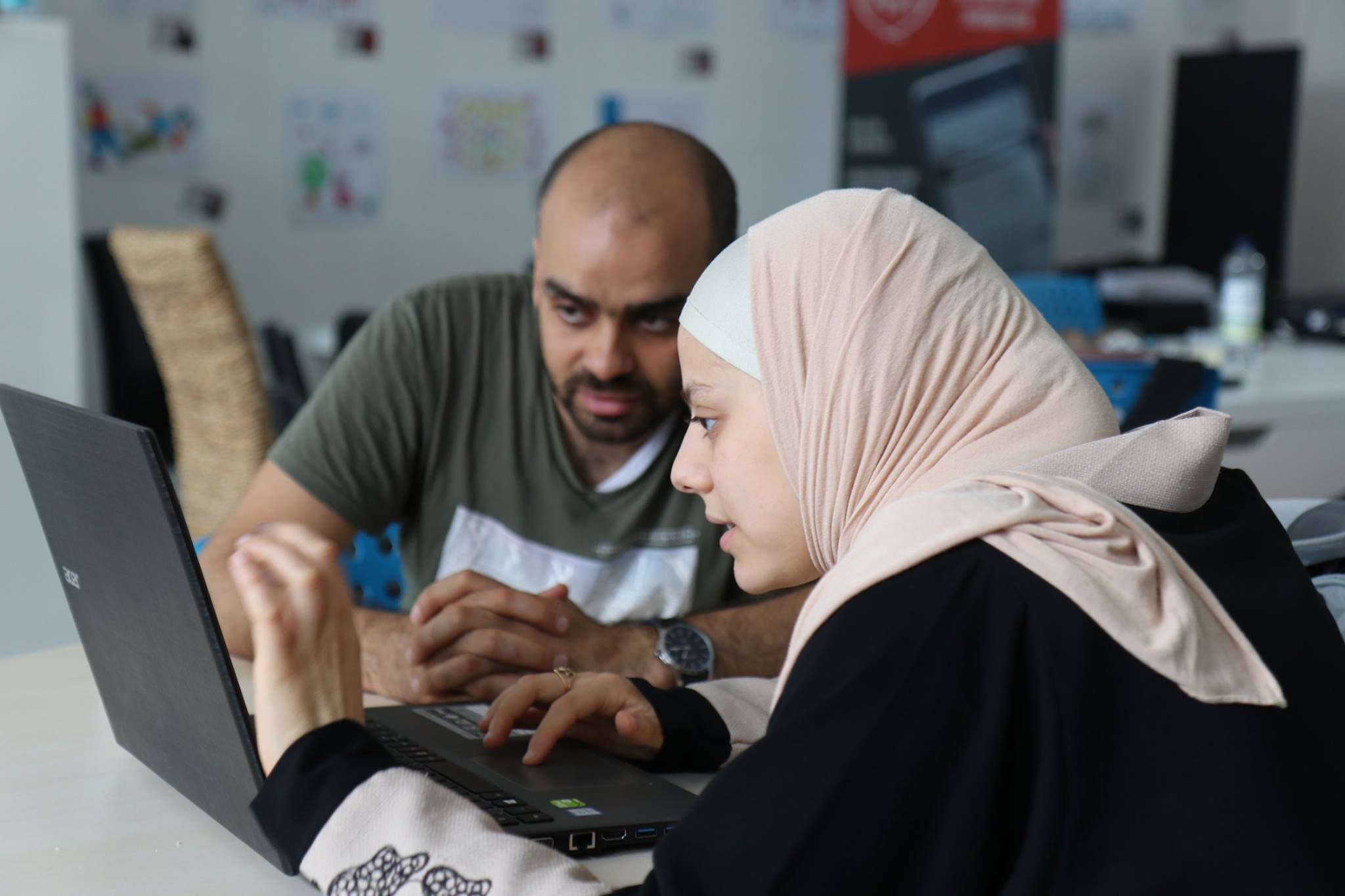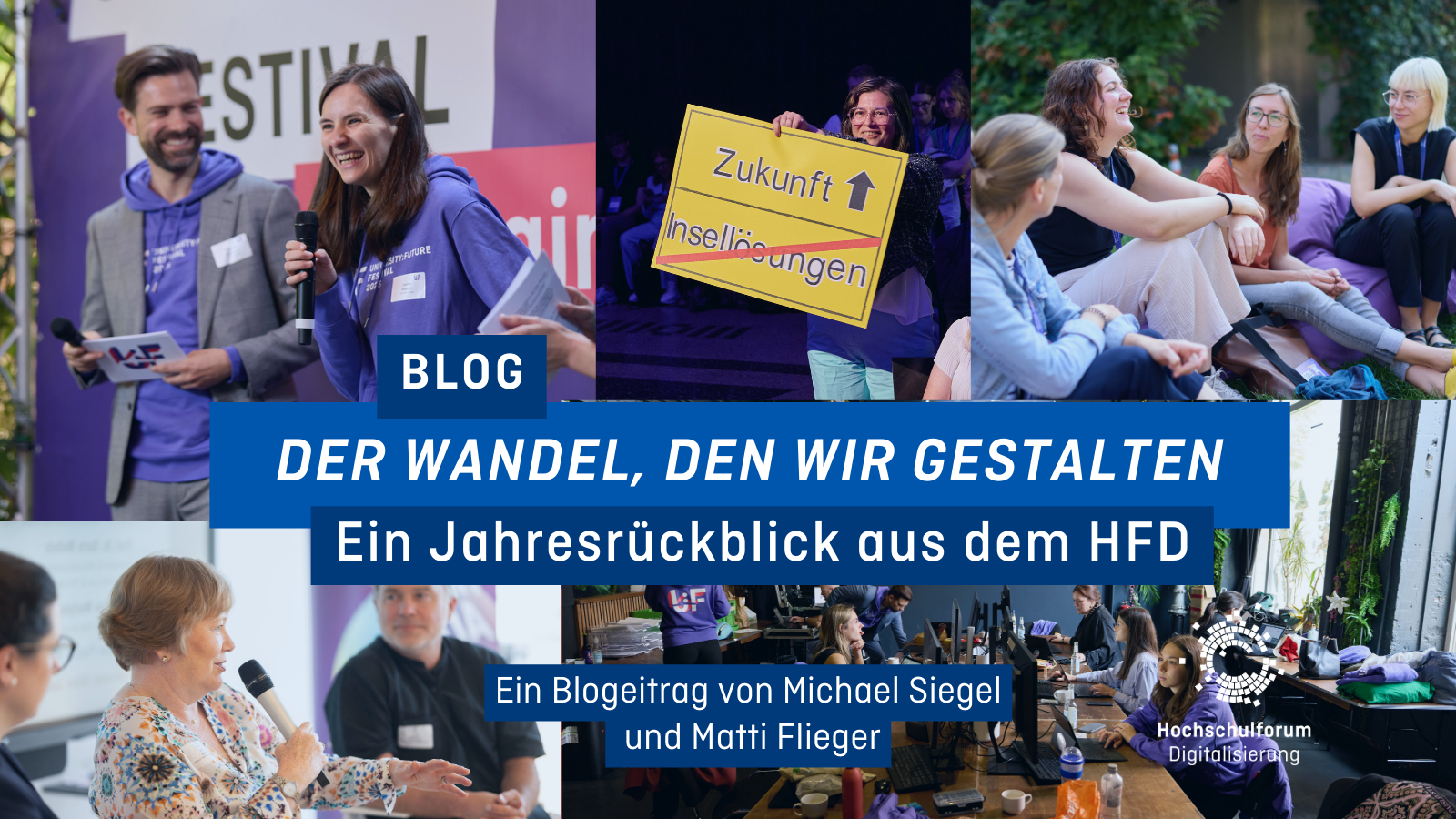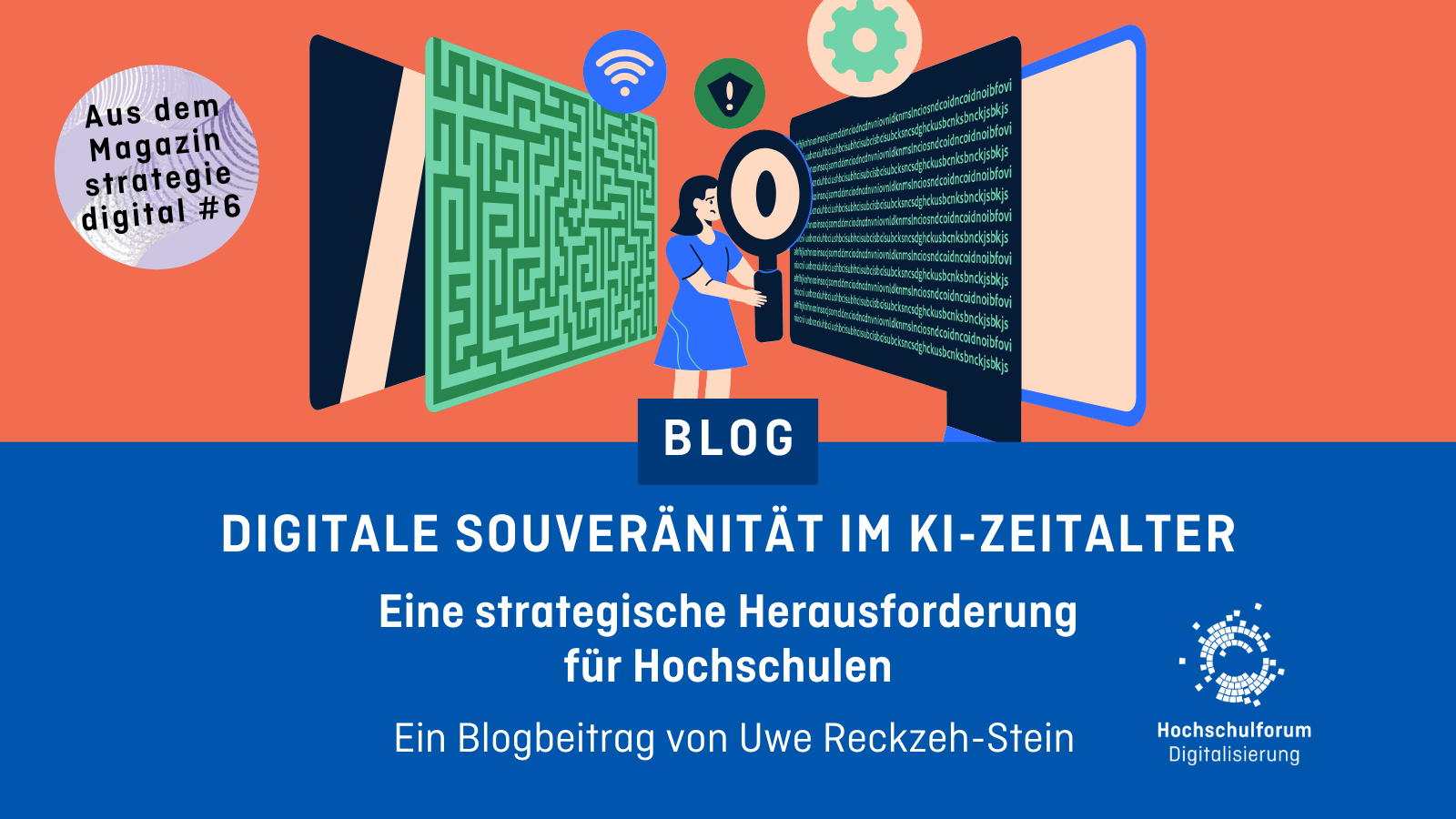“Bologna Digital” – Reinforcing the European Higher Education Area with Digital Solutions
“Bologna Digital” – Reinforcing the European Higher Education Area with Digital Solutions
06.02.19
Not to consider digital change as an additional challenge, but as an effective means to address key challenges for higher education: This is the central message of the position paper “Bologna Digital”, which was initiated by several experts. It has now been published on the occasion of the meeting of European education and science ministers in May 2018. Florian Rampelt, Dominic Orr and Renata Suter have summarised the paper for our blog.
![Digitalisierung muss in der Breite ankommen. [https://pxhere.com/de/photo/126747 Bild]](/sites/default/files/images/blog/creative-light-night-photography-steel-lens-126747-pxhere.com_.jpg)
Summary
With backing from HFD, an international team of experts in the “Bologna Digital” position paper set out impetuses for the Bologna-Ministerial Conference in May 2018 in Paris. The position paper in English can be accessed here.
A key assertion in “Bologna Digital” is that the digital turn should not be regarded as a sideshow but as an effective means for dealing with central challenges facing 21st century education. However, solid support and mainstream visibility for digitalizing higher education is still lacking and the direct contribution by digital solutions to overcoming critical challenges often remain obscured. Discussions therefore ensue on the basis of specific proposals how digitalization can be anchored by 2020 in the ongoing implementation of the Bologna process as a theme spanning all dimensions – and thus become part of the solution to existing challenges. A total of 17 recommendations encourage universities to make introductory digital courses available online in their degree programs (possibly as MOOCs) so that especially students from undereducated strata and from abroad can get advance information and be better prepared for their studies. Moreover, universities are challenged to develop standardized procedures and processes for testing and crediting skills acquired in various (open) online formats and to publicize them. This goes hand in hand with the call for quality control measures for digital teaching and learning formats that piggyback on the existing Bologna standards, to build confidence in dealing with digital learning processes. In addition, options for virtual exchanges – depicted as central elements for the digital university of the future – should receive stronger emphasis in the Bologna working program.
![Hier entlang: die Bildungs- und Wissenschaftsminister(innen) treffen sich in Paris. [https://pxhere.com/de/photo/830976 Bild]](/sites/default/files/images/blog/architecture-sunset-bridge-traffic-night-city-830976-pxhere.com_.jpg)
In May 2018, education and science ministers of the 48 European Higher Education Area (EHEA) states met for discussions on Bologna process priorities and the working program for the next few years. Twenty years after the Sorbonne Declaration focused on issues, such as the opening of higher education, common frameworks for teaching and learning, credit for qualifications, and the fostering of internationalization and mobility, they still present big challenges. The authors and supporters of “Bologna Digital” argue that digitalization can make a substantial contribution to overcoming them. Core arguments and best practice examples worked up by HFD in the meantime have flowed into the discussion, for example, as summarized in HFD’s “The Digital Turn” final report.
An important premise for “Bologna Digital” is the finding that digitalization, both as part of the Bologna process and in the university practice that goes even further, was generally not ignored. Indeed, in many places, good ideas were developed and effective steps were taken. Strategic-conceptual work on the potential value added by digitalization in meeting key challenges like opening higher education in Europe in particular was reinforced in recent years by the European Commission (see Inamorato dos Santos, Punie, & Muñoz, 2016). Out of this grew in January 2018 a Digital Education Action Plan. Universities, education officials, and many other stakeholders and networks contributed actively to digital solutions already playing a significant role in many learning venues (on this see, for example, Wannemacher et al., 2016).
Digitalization’s full potential nevertheless could not yet be realized on the systems level. Concrete support and visibility for digitalization from mainstream higher education continue to fall short, and the direct contributions by digital solutions to meeting key challenges in higher education are often obscured. In what follows, therefore, both the different core themes and recommendations of the position paper will be detailed and, moreover, a direct relationship established to best practice cases that could serve as models for possible additional action alternatives.
Opening higher education
![Digitale Unterstützungsangebote helfen die Hochschulen für verschiedene Zielgruppen zu öffnen. [https://pxhere.com/de/photo/617659 Bild]](/sites/default/files/images/blog/black-and-white-track-white-texture-number-line-617659-pxhere.com_.jpg)
The challenge of reaching a student population that mirrors society’s diversity and providing equal opportunity access to higher education for all regardless of their origin is treated as a “social dimension” in the Bologna process. Achieving greater equality of opportunity and freedom of choice go hand in hand in this context with an insufficiently fulfilled need for effective information, counseling, and support offers and for enabling flexible, individual educational biographies (Orr, Usher, Haj, Atherton, & Geanta, 2017). Increasingly, the question of how to give consideration to interrupted educational biographies, say with respect to the situation of refugees, can play an important role in this.
The EU project “PL4SD – Peer Learning for the Social Dimension“, roughly until 2015 managed to identify many instances of counseling and support for students in the European education area. Two key obstacles, however, were that a) it is difficult to reach those learners that need support the most, and b) financial and personal resources are often too limited to permit expanding support measures to the requisite degree. Better utilization of digital tools in learning environments could create, for instance, personalized offers tailored to differing advance knowledge and personal needs of students for meeting these challenges.
In past years, various countries also paid particular attention to (digital) bridging courses designed to let students achieve a uniform skill level when they start their studies. The OMB+ online preparatory math course in which many universities participate is an example of this.
Precisely in response to the large refugee numbers that came to Europe starting in 2015, various stakeholders also developed digital information and introductory courses especially for this target group. Examples here include the work by Kiron Open Higher Education, which resulted in the MOOC-based online curricula for study preparation and starting studies in different disciplines. A further example of digital dissemination measures are the course offerings of Lübeck-based oncampus GmbH, such as the fit4uni program for getting ready to study at a university in Germany. These types of approaches, possibly in connection with a national higher education platform, also hold potential for generally giving higher education more visibility in society.
Recommendations:
- We encourage universities to make online introductory courses available in their degree programs, including appropriate support functions, so that new students have more advance knowledge and are better prepared for their studies.
- We ask governments and the European Union to makes available financial resources for such digital solutions, to open up higher education and, especially, also to ensure learning success for non-traditional learners.
Giving credit for non-formal (digital) learning
![Auch nicht-formelle Lernerfahrungen sollen anerkannt werden. [https://pxhere.com/de/photo/895692 Bild (bearbeitet)]](/sites/default/files/images/blog/suit-advertising-color-blue-clothing-colorful-895692-pxhere.com_.jpg)
Issues relating to acceptance and credit for learning in different and flexible learning venues (both formal and informal) even twenty years after the Sorbonne Declaration continue to be a challenge. This holds true particularly for giving credit for prior learning over the entire educational biography of lifelong learners both within and outside formal study programs. When higher education vendors recognize and expand the increasing learning options in digital education areas, they can set learners on new learning pathways in and through higher education that are more responsive not only to learner needs but also to the labor market.
Both in the European Higher Education Area and in Germany, in recent years unquestionably great advances were made in this realm, particularly in competencies acquired from analog sources (European Commission / EACEA / Eurydice, 2015). In Germany, potential processes were highlighted and guidelines created, for instance, by the BMBF’s “ANKOM – transitions from vocational to academic education” initiative.
When confronted with skills acquired non-formally in digital learning environments, many universities are still highly uncertain about their equivalence with formal higher education offers. For one, quality standards for (open) online courses do not appear to be uniformly and transparently verifiable: “For crediting competencies acquired in non-academic settings, (appropriate) quality-controlled criteria and standards must be established. Applying these criteria should let the universities determine if digitally-acquired knowledge is equivalent to conventional curricula (equivalence testing) (Topic group Curriculum Design & Quality Development, 2016).
Recommendations:
- We encourage institutions of higher education to develop standardized procedures and processes for testing and crediting skills that were acquired in various (open) online formats and to publicize them. This should build on quality control measures by vendors of MOOCS and other formats. The measures can promote a progressive transition of non-traditional learners into study programs as well as more flexible education pathways.
- We invite universities to publish lists of online courses (e.g., MOOCs) and microcredentials that they recognize or give credit for as part of their programs and to develop transparent digital credit management systems.
Admissions
![Digitale Zulassungsprozesse können Verzögerungen und Frustration vermeiden. [https://pxhere.com/de/photo/957625 Bild]](/sites/default/files/images/blog/airport-signage-public-transport-welcome-tourist-attraction-input-957625-pxhere.com_.jpg)
While degree programs today of course are described online on university websites and specialized study portals, the university admissions process is still largely drawn out and paper-intensive. Paper-based intake procedures are often expensive, not transparent enough and cause frustrating delays, particularly when it comes to international students. Digitalizing evaluation and admissions can make it easier for prospective students and simultaneously reduce institutional effort and costs. Naturally, this can only succeed if data privacy and data security are safeguarded. Systems development and adaptation for working with digital student data could be based, for instance, on the principles formulated in the Groningen Declaration.
The EMREX project represents a possible solution to the problems of transferring student data internationally between universities. Supported by state and university stakeholders in five European countries, it holds promise for creating more transparency, quality, and reliability for student data.
Recommendations:
- We challenge universities to phase out paper-intensive admissions processes and move instead to using electronic student data, so that recognition and admissions processes modeled on the Groning Declaration principles inform better, are more secure, and faster.
- Governments and the European Union are encouraged to support the installation and networking of central (national) electronic storage for student data in conformity with the principles outlined in the Groningen Declaration, while taking appropriate steps to ensure a high degree of data security and data privacy.
- The EU Student Card proposed by the European Commission should be developed as a (virtual) I.D. for lifelong learning to make admissions decision easier for a much larger group of learners than only young students.
Teaching and Learning

Teaching and learning are the heart of higher education. As such, various declarations by the Bologna ministers espouse putting the learner in the center. This call for a learner-centered approach to learning is not new. However, providing this type of learning in an institutional framework and widely is not easy. Open educational resources and peer learning networks are two examples of digital solutions that can make it easier to meet this challenge. Europe-wide initiatives could be studied as central resources and templates for national solutions.
Hence, a learner-centered approach calls for stronger institutional sponsorship for such digital learning environments. The acceptance of open educational resources (OER) must therefore be raised. On the whole, a key success factor for this on the one hand is boosting collaboration between universities for mutual learning but also collectively ensuring the use of high-quality digital educational materials.
In the United States, the Personalized Learning Consortium for example supports American universities experimenting with adaptive digital learning environments with the aim of developing innovative learner mentoring methods and successful learning outcomes. Another example is furnished by the University of Derby (UK), which supports students with personalized assessment feedback as part of its overall strategy for excellence in teaching and learning. This strategy in 2017 earned it the Teaching Excellence Framework (TEF)’s gold award. Edinburgh University provides its learners and teachers with a collaborative, digital learning environment in which open educational resources (OER) are offered and can be shared and developed further. Recently, it adopted a digitalization strategy for the entire university as part of it.
Recommendations:
- Institutions of higher education are encouraged to promote digital learning environments as an important pillar of their institutional strategy for improving the learning experience and outcomes of all learners.
- Institutions of higher education are encouraged to collaborate in developing digital learning environments (e.g., in the use and further development of open educational materials) to ensure mutual learning and quality improvements between academic institutions.
- We call on governments and the European Union to allocate funds for institutions of higher learning and other stakeholder to support pedagogical innovations by the teaching staff.
- All stakeholders are invited to examine the idea for a Europe-wide platform for digital university education and intensified collaboration (one-stop shop).
Degrees and Qualifications

Will the high school diploma remain the sole qualification? A central element in the Bologna process and basis for a common framework for European higher education was agreement on a tiered study structure (short cycles, Bachelor’s, Masters and PhD programs). Along with it went the introduction of the European Credit Transfer and Accumulation System covering credit points earned for learning progress. Still, today’s growing variety of offerings and different options for accessing higher education raise two additional questions: Should qualifications awarded at the end of a degree program continue as the sole form of documentation and certification? Or should there be more focus in the future on smaller learning units that facilitate more flexible ways of study progress? For the latter question, moreover, consideration should be given to matching university qualifications to the demands of the future labor market, given that employers seem increasingly interested in the so-called “soft” or social skills.
Universities should clearly use digital options more intensively for documenting such alternative qualifications. Particularly open badges, i.e., digital insignia, and other innovative portfolio approaches should be implemented even more widely in universities for documenting competencies acquired during school. The same goes for recognizing accumulated prior experiences more reliably, transparently, and portably and linking them to formal degree programs. Likewise, earning newer forms like micro-credentials can be documented and integrated as well as lead eventually to better meeting the new labor market requirements.
Recommendations:
- Universities are encouraged to field digital solutions (e.g., digital badges) to ensure a more fine-grained documentation of knowledge, abilities, skills and experiences that learners acquires in the course of lifelong learning progress.
The EU is encouraged to continue its efforts with governments and other stakeholders to conceptualize Europe-wide reforms with high labor market acceptance (e.g., the Europass) and to implement them.
Internationalisation and mobility
![Leinen los! Digitalisierung soll zur Mobilität beitragen. [https://pxhere.com/de/photo/705346 Bild]](/sites/default/files/images/blog/screen-beach-ocean-rope-technology-sunset-705346-pxhere.com_.jpg)
Not only are internationalization and mobility of students and staff a central pillar of the Bologna process, but they are also fundamental prerequisites for citizens to see themselves as open to the world, which also favors improved social cohesion between the peoples of different nations. The Erasmus program and various similar national initiatives for many years have successfully supported international mobility for students and staff. It nevertheless seems that large parts of the student population but also many university employees continue to be excluded from mobility experiences – particularly many non-traditional students are unlikely to be internationally mobile during their studies. (Orr, 2012). To facilitate an internationally-open campus life in situ, more initiatives need to be seized which support “internationalization at home” for all students and university personnel. It also bears mention that in the Bachelors area, student drop-out rates among international students are still higher than comparable national numbers. (Burkhart & Kercher, 2014).
In January 2018, the European Commission kicked off the pilot phase of the Erasmus+ Virtual Exchange. The program offers young people a low-threshold entry, digital path to intercultural exchange. Working together with youth organizations and universities, it is open to anyone between the ages of 18 and 30 who live in Europe or the southern Mediterranean. The program is implemented by a consortium consisting of the Anna Lindh Foundation, UNIMED, Sharing Perspectives Foundation and Soliya, UNICollaboration, Kiron Open Higher Education and Migration Matters. Diverse online courses make up part of the pilot stage that are attended by university students throughout Europe together with young people not (yet) enrolled in studies.
RWTH Aachen University, as part of the INTEGRAL² joint project has opened MOOCs from its Bachelors program explicitly for Erasmus students to avail themselves of digital studies at their own pace as a complement to their brick-and-mortar classes. With course offerings like the European Business Administration (EBWL) MOOC, students can get an “overview of fundamental models, theories, and principles of business administration studies” in the host country.
Recommendations:
- We exhort the universities to utilized options for virtual exchange even more strongly as a complement to traditional exchange programs for students and university employees.Hochschulen werden dazu ermutigt, We encourage universities to make introductory courses to their degree program available online to provide international students with better advance information and better preparation for on-campus studies abroad.
Quality control
![Ist alles top? Standards zur Qualitätssicherung runden das Positionspapier ab. [https://pxhere.com/de/photo/1225341 Bild]](/sites/default/files/images/blog/hand-audience-blue-thumbs-up-great-match-1225341-pxhere.com_.jpg)
It is not just since adoption of “Quality Education” as the fourth “Sustainable Development Goal” (SDG 4) that the idea of quality plays a key role in the discourse on high-quality and effective educational offerings. In digital teach and learn scenarios alone, because of the theoretically unlimited availability of educational resources, options for guiding not just students and teachers but also producers of educational materials through applying transparent quality standards are especially important. In the Bologna process a framework was created especially through the “Standards and guidelines for quality control in the European Higher Education Area“ designed to make comprehensive transparency and trust possible. Under the framework conditions for digitalization what counts is developing such guidelines with special focus on challenges and framework conditions of digital teach and learn scenarios and ultimately also creating fitting assessment criteria. That said, these by no means need to be novel; instead, they only need to explicitly and clearly relate existing guidelines to the digital context to effectively reduce uncertainties.
Witthaus et al. (2016) haben für die Europäische Kommission Faktoren zusammengefasst, die die Beurteilung der Qualität und der damit verbundenen Anrechenbarkeit von MOOCs durch Hochschulen wesentlich erleichtern. Auf Grundlage dieser Faktoren haben die Autoren ein Ampel-Modell erstellt, mit dem MOOC-Anbieter bestimmte Qualitätsstandards transparent aufbereiten und leicht zugänglich darstellen können. Auch die Partnerhochschulen der von der EADTU koordinierten Initiative und MOOC-Plattform OpenupEd haben einen gemeinsamen Rahmen für Qualitätsmerkmale von MOOCs erstellt und darauf basierend ein eigenes Qualitätslabel für MOOCs entwickelt. Kiron Open Higher Education hat für die standardisierte Bewertung seiner MOOC-basierten Curricula neben allgemeinen Qualitätssicherungsmaßnahmen als neues Transparenzinstrument sogenannte MOOklets entwickelt.
Witthaus et al. (2016) summarized the factors for the European Commission that significantly ease making quality judgments and the recognition of MOOC credits by universities. Based on these factors, the authors devised a traffic light model with which MOOC providers can illustrate certain quality standards transparently and in an easily accessible manner. Also, the partner universities of the initiatives coordinated by the European Association of Distance Teaching Universities (EADTU) and the OpenupEd MOOC platform have set up a common framework for quality characteristics in MOOCs and developed their own quality label für MOOCs. Kiron Open Higher Education, besides developing general quality control mechanisms for the standardized evaluation of its MOOC-based curricula, has come up with a new class of transparency instruments, the so-called MOOClets.
Recommendations:
- All stakeholders in the education area, but also and especially the EU and the Bologna Follow-up Group (BFUG), are encouraged to step up the joint effort to develop universal quality criteria that aid higher education institutions, students and evaluators in assessing the quality and relevance of online learning offers and alternative learning certificates.
- The member states and other stakeholders in the European Higher Education Area are challenged to reevaluate their current quality control and accreditation policies and to broaden these into suitable procedures for new forms of (digital) lifelong learning. In this context, governments and interest groups would do well to promote the creation of one or more specialized (European) agencies with a focus on rating digital lifelong learning offerings such as MOOCs.
The author team and the various sponsors hope that the position paper will make for a more dynamic discourse, one that also provides the impetus for specific next steps. The authors will be glad to hear from you directly or via Twitter under #BolognaDigital.
About the “Bologna Digital” position paper
The position paper, coordinated by Kiron Open Higher Education, was written by the authoring team consisting of Dr. Dominic Orr, Peter van der Hijden, Florian Rampelt, Ronny Röwert and Dr. Renata Suter. It was circulated for discussion in various draft version starting in December 2017 among stakeholders in the university sector. After publication, with its key demands for paying more attention to and fostering of the digital dimension in the Bologna Process served as impetus for the Bologna Minister Conference of 24 May 2018 in Paris. It was supported by the Bertelsmann Foundation, German Forum for Higher Education in the Digital Age (HFD), the European Association of Distance Teaching Universities (EADTU), the Groningen Declaration Network(GDN) and the Research Institute for the Economics of Education and Social Affairs (FiBS).
Further reading:
Burkhart, S., & Kercher, J. (2014). Abbruchquoten ausländischer Studierender. DAAD Blickpunkt. Bonn: Deutscher Akademischer Austauschdienst (DAAD). Verfügbar unter https://www.daad.de/medien/der-daad/analysen-studien/final_blickpunkt-abbruchquoten.pdf
European Commission/EACEA/Eurydice. (2015). European Higher Education Area in 2015: Bologna Process Implementation Report. Luxemburg: Publications Office of the European Union. Verfügbar unter http://www.ehea.info/pid34367/implementation-and-national-reports.html
European Commission. (2018). Communication from the Commission to the European Parliament, the Council, the European Economic and Social Committee and the Committee of the Regions on the Digital Education Action Plan. Brüssel: Europäische Kommission. Verfügbar unter https://ec.europa.eu/education/sites/education/files/digital-education-action-plan.pdf
Hochschulforum Digitalisierung (2016). The Digital Turn – Hochschulbildung im digitalen
Zeitalter. Arbeitspapier Nr. 27. Berlin: Hochschulforum Digitalisierung. Verfügbar unter https://hochschulforumdigitalisierung.de/sites/default/files/dateien/Abschlussbericht.pdf
Inamorato dos Santos, A., Punie, Y., & Muñoz, J. C. (2016). Opening Up Education: A Support Framework for Higher Education Institutions. Luxemburg: Publications Office of the European Union. Verfügbar unter https://ec.europa.eu/jrc/en/publication/eur-scientific-and-technical-research-reports/opening-education-support-framework-higher-education-institutions
Jansen, D., & Konings, L. (2017). MOOC Strategies of European Institutions. Status report based on a mapping survey conducted in November 2016 – February 2017. Maastricht: European Association of Distance Teaching Universities (EADTU). Verfügbar unter http://eadtu.eu/documents/Publications/OEenM/MOOC_Strategies_of_European_Institutions.pdf
Orr, D. (2012). Mobility is not for all. Tying it all together. Bonn: Lemmens. Verfügbar unter http://www.aca-secretariat.be/fileadmin/aca_docs/images/members/ACA_2012_Tying_it_together..pdf
Orr, D., Usher, A., Haj, C., Atherton, G., & Geanta, I. (2017). Study on the impact of admission systems on higher education outcomes Volume I: Comparative report (Vol. I). Luxemburg: Publications Office of the European Union. Verfügbar unter https://doi.org/10.2766/943076
Rampelt, F. & Suter, R. (2017). Recognition of prior learning – outcome-oriented approaches to the recognition and assessment of MOOC-based digital learning scenarios. In L. Gómez Chova, A. López Martínez & I. Candel Torres (Hrsg.), EduLearn 2017. 9th Annual International Conference on Education and New Learning Technologies (S. 6645-6653). Barcelona.
Standards und Leitlinien für die Qualitätssicherung im Europäischen. Hochschulraum. (ESG). (2015), Bonn: Hochschulrektorenkonferenz (HRK). Verfügbar unter https://www.hrk.de/uploads/media/ESG_German_and_English_2015.pdf
Themengruppe Curriculum Design & Qualitätsentwicklung (2016). Anerkennung, Anrechnung und
Zertifizierung von digitalen Lehr- und Lernangeboten. Arbeitspapier Nr. 8. Berlin: Hochschulforum
Digitalisierung. Verfügbar unter https://hochschulforumdigitalisierung.de/sites/default/files/dateien/HFD%20AP%20Nr%208_Anerkennung%2C%20Anrechnung%20und%20Zertifizierung.pdf
Wannemacher, K., Jungermann, I. Scholz, J., Tercanli, H. & Villiez, A. (2016). Digitale Lernszenarien im Hochschulbereich. Arbeitspapier Nr. 15. Berlin: Hochschulforum Digitalisierung. Verfügbar unter https://hochschulforumdigitalisierung.de/sites/default/files/dateien/HFD%20AP%20Nr%2015_Digitale%20Lernszenarien.pdf
Witthaus, G., Inamorato dos Santos, A., Childs, M., Tannhäuser, A., Conole, G., Nkuyubwatsi, B., & Punie, Y. (2016). Validation of Non-formal MOOC-based Learning: An Analysis of Assessment and Recognition Practices in Europe (OpenCred). Luxemburg: Publications Office of the European Union. Verfügbar unter http://publications.jrc.ec.europa.eu/repository/bitstream/JRC96968/lfna27660enn.pdf




 Michael Siegel
Michael Siegel 
 Andreas Giesbert
Andreas Giesbert 
 Uwe Reckzeh-Stein
Uwe Reckzeh-Stein 